Subtotal: £2.91
Bring Vibrancy and Beauty to Your Aquarium with the Andinoacara Rivulatus – Green Terror – South American Cichlid, Stunning Colors for Peaceful Community Tanks
£11.49 Original price was: £11.49.£9.68Current price is: £9.68.
Welcome these beautiful Andinoacara Rivulatus, known as Green Terror Cichlids, into your aquarium. Their vibrant green bodies and striking red and blue markings create a stunning focal point. Perfect for aquarists seeking colorful freshwater fish that thrive in community tanks.
1964 in stock
Species Introduction
The Andinoacara Rivulatus, commonly known as the Green Terror Cichlid, is a stunning freshwater fish native to the rivers and lakes of South America, particularly in the regions of Ecuador and Colombia. These vibrant cichlids are characterized by their striking coloration, which can range from bright green to deep blue, often highlighted by shimmering spots and patterns that add to their allure in an aquarium setting. As a member of the cichlid family, the Green Terror exhibits a variety of behaviors that make them fascinating to observe. They thrive in environments that mimic their natural habitat, which includes rocky substrates and dense vegetation. When providing a loving home for these beautiful creatures, it is essential to understand their specific needs and preferences to ensure their health and happiness within a community tank.
Care Requirements Dashboard
| Optimal Living Conditions | |
|---|---|
| Water Temperature | 24-27°C (75-81°F) |
| pH Level | 6.5-7.5 |
| Water Hardness | 4-12 dKH |
| Minimum Tank Size | 80L (20 gal) |
| Salinity | Freshwater |
| Care Level | Beginner Friendly |
Natural Behavior & Temperament
The Green Terror Cichlid is known for its vibrant personality and dynamic behavior. These fish are semi-aggressive, particularly during breeding seasons or when establishing their territories. They exhibit unique swimming patterns, often darting around the tank and exploring their environment. In a community tank, it is essential to choose tank mates wisely, as their territorial nature can lead to conflicts. However, when housed with compatible species, they can display fascinating social behaviors, including forming pairs and engaging in playful interactions. Observing their interactions can provide insights into their complex social structures and hierarchy within the aquarium.
Tank Setup Guide
Creating an ideal environment for the Green Terror Cichlid involves replicating their natural habitat as closely as possible. Begin by selecting a spacious aquarium with a minimum capacity of 30 gallons. Incorporate a sandy or gravel substrate that allows for digging and burrowing, as these behaviors are natural for cichlids. Adding rocks, caves, and driftwood will provide hiding spots and territories for your fish friends, reducing stress and aggression. Live plants can enhance the aesthetic appeal of the tank while also contributing to water quality by absorbing excess nutrients. Ensure that the decorations are securely placed to prevent any potential hazards during swimming or territorial disputes.
Water Quality Management
Maintaining high water quality is paramount for the health and longevity of the Green Terror Cichlid. Regular testing of water parameters, including pH, ammonia, nitrite, and nitrate levels, is essential to ensure a stable environment. The ideal pH range is between 6.5 and 7.5, with temperatures maintained between 75°F and 82°F. It is crucial to avoid sudden fluctuations in temperature or pH, as these can stress the fish and lead to health issues. Additionally, using a high-quality filtration system will help keep the water clean and clear, while regular water changes will remove toxins and replenish essential minerals. A well-maintained aquarium contributes significantly to the overall well-being of your aquatic companions.
Feeding & Nutrition
The Green Terror Cichlid is an omnivorous species, requiring a balanced diet to thrive. In their natural habitat, they consume a variety of foods, including insects, crustaceans, and plant matter. In an aquarium setting, providing a high-quality cichlid pellet or flake food as a staple diet is essential. Supplementing their diet with frozen or live foods, such as brine shrimp, bloodworms, and daphnia, will enhance their coloration and overall health. A feeding schedule of 2-3 times per day, offering only what they can consume in a few minutes, will help prevent overfeeding and maintain water quality. Always monitor their health and adjust their diet as needed to ensure optimal growth and vitality.
Compatibility Guide
When considering tank mates for the Green Terror Cichlid, it is crucial to select species that can coexist peacefully. Due to their semi-aggressive nature, they are best suited to a community tank with other robust fish that can handle some level of territorial behavior. Suitable tank mates include larger tetras, barbs, and other cichlids that share similar water parameter requirements. Avoid housing them with small or timid fish, as they may become targets for aggression. It’s essential to monitor interactions closely, especially during the initial introduction phase, to ensure a harmonious environment for all inhabitants.
Health & Wellness
The health and wellness of the Green Terror Cichlid depend on several factors, including water quality, diet, and stress management. Common health issues include ich, fin rot, and other parasitic infections, which can arise from poor water conditions or stress. Regularly observing your fish for signs of illness, such as changes in behavior, appetite, or physical appearance, is crucial for early detection and treatment. Maintaining a stable environment, providing a varied diet, and ensuring adequate hiding spots will help reduce stress and promote a strong immune system. In case of illness, consult a veterinarian specializing in fish health for appropriate treatment options.
Breeding Information
Breeding the Green Terror Cichlid can be a rewarding experience for aquarists. These fish are known to form strong pair bonds, and once a pair is established, they will engage in elaborate courtship behaviors. To encourage breeding, provide a separate breeding tank with suitable substrate for laying eggs, such as flat rocks or clay pots. The female will lay eggs, which the male will fertilize, and both parents will take turns guarding the eggs and fry once they hatch. Fry care is essential, as they are vulnerable during the early stages of development. Providing infusoria or finely crushed food will support their growth until they are large enough to consume regular cichlid pellets.
Acclimation Process
Introducing new fish to your aquarium requires a careful acclimation process to minimize stress and ensure a smooth transition. Begin by floating the sealed bag containing the Green Terror Cichlid in the aquarium for about 15-20 minutes to equalize the temperature. After this, gradually introduce small amounts of tank water into the bag over the next hour. This process helps the fish adjust to the water parameters of the aquarium. Once acclimated, gently release the fish into the tank using a net, avoiding adding bag water to the aquarium. Monitoring their behavior and interactions with existing tank mates during the first few days is crucial to ensure a successful acclimation.
Long-term Care
The Green Terror Cichlid can live for several years with proper care, making them a long-term commitment for any aquarist. As they grow, their needs may change, requiring adjustments to their diet, tank size, or environment. Regular monitoring of water parameters and health is essential to ensure their longevity. Additionally, providing enrichment through decorations, hiding spots, and varied diets will contribute to their overall well-being. As they mature, they may exhibit changes in behavior or coloration, reflecting their growth and development. Understanding their lifecycle and adapting care practices accordingly will enhance their quality of life.
Natural Habitat Recreation
Recreating the natural habitat of the Green Terror Cichlid is essential for their health and happiness. In the wild, they inhabit rivers and lakes with rocky substrates and dense vegetation. To mimic this environment, incorporate natural elements such as rocks, caves, and driftwood into your aquarium setup. Use a sandy substrate to allow for natural digging behaviors, and consider adding live plants to enhance the aesthetic appeal while providing cover. This biotope setup not only benefits the fish but also creates a visually stunning aquarium that showcases the beauty of these vibrant cichlids.
Seasonal Care Adjustments
As seasons change, so do the needs of your aquarium. During warmer months, it may be necessary to monitor water temperature closely, ensuring it remains within the preferred range for the Green Terror Cichlid. Consider using a heater during colder months and monitoring for any fluctuations that could stress your fish. Additionally, adjusting lighting schedules to mimic natural daylight patterns can promote healthy growth and behavior. Seasonal changes may also affect feeding habits and water quality, so remain vigilant and adapt your care practices accordingly to maintain a stable environment.
Expert Tips
For those looking to enhance their experience with the Green Terror Cichlid, consider implementing these expert tips. First, invest in a high-quality filtration system to maintain optimal water quality, as these fish are sensitive to changes in their environment. Additionally, providing a varied diet will not only support their health but also enhance their coloration and vitality. Regularly rearranging decorations and introducing new elements can stimulate their curiosity and reduce boredom. Lastly, engaging with your fish friends through observation and interaction will deepen your appreciation for their unique behaviors and personalities.
Troubleshooting
Despite your best efforts, challenges may arise in maintaining a healthy aquarium for your Green Terror Cichlid. Common issues include aggression towards tank mates, which can often be mitigated by providing ample hiding spots and establishing territories. If health issues occur, such as signs of stress or illness, immediate action is necessary. Isolate affected fish and consult a veterinarian specializing in aquatic health for guidance on treatment options. Regularly testing water parameters and making necessary adjustments will help prevent many common problems, ensuring a stable environment for your aquatic companions.
Scientific Background
The Andinoacara Rivulatus belongs to the cichlid family, which is known for its diverse range of species and complex behaviors. This particular species has been the subject of various studies focusing on its breeding habits, social structures, and adaptability to different environments. Understanding the scientific background of the Green Terror Cichlid can enhance your appreciation for these fish and inform your care practices. Research into their natural habitats and behaviors can provide valuable insights into creating a suitable environment that mimics their wild counterparts.
Advanced Care Techniques
For experienced aquarists looking to elevate their care for the Green Terror Cichlid, consider implementing advanced techniques such as breeding conditioning and specialized feeding protocols. Conditioning breeding pairs with high-quality live foods can enhance reproductive success and fry health. Additionally, utilizing a breeding box or separate tank for fry will ensure their safety and promote healthy growth. Regularly engaging with your fish through observation and interaction can also provide insights into their behavior and preferences, allowing for a more tailored care approach that meets their individual needs.
Frequently Asked Questions
Q: What tank size is required for the Andinoacara Rivulatus?
The Andinoacara Rivulatus, commonly known as the Green Terror, thrives in a tank of at least 75 litres. This size allows ample space for swimming and establishing territories, which is crucial for their well-being. A larger tank is recommended if you plan to keep more than one individual, as these fish can be territorial, especially during breeding. It is essential to provide hiding spots using rocks or plants, which can help reduce stress and aggression. A well-planned aquarium setup will not only enhance their beauty but also promote healthier behaviour.
✓ Expert Tip
Consider using a tank divider if introducing multiple Green Terrors to prevent conflict.
Q: What water parameters do Green Terrors require?
Green Terrors prefer slightly acidic to neutral water conditions, with a pH range of 6.5 to 7.5. The temperature should be maintained between 24°C and 28°C. Regular water changes are vital to keep nitrate levels low, ideally under 20 ppm, which helps prevent stress and disease. It’s also beneficial to use a quality water conditioner to remove harmful chemicals. Testing kits for pH, ammonia, nitrite, and nitrate should be part of your routine to ensure a stable environment for these vibrant fish.
✓ Expert Tip
Introduce water changes gradually to avoid shocking your fish.
Q: How often should I feed my Green Terror?
Feeding your Green Terror should occur two to three times a day, providing only what they can consume within a few minutes. A balanced diet is essential, including high-quality cichlid pellets, frozen or live foods such as brine shrimp, and vegetable matter like blanched zucchini. Overfeeding can lead to water quality issues and health problems, so it’s crucial to monitor their food intake. Adjust the quantity based on their size and activity level to ensure they remain healthy and vibrant.
✓ Expert Tip
Consider varying their diet to enhance colouration and overall health.
Q: What are the best tank mates for Green Terrors?
When selecting tank mates for Green Terrors, it is crucial to choose species that can tolerate their sometimes aggressive behaviour. Suitable companions include larger tetras, certain catfish, and other robust cichlids such as convicts or firemouths. Avoid smaller fish, as they may be seen as prey. Additionally, ensure the tank is spacious enough to provide hiding spots and territories to reduce potential conflicts. Introducing new fish should be done cautiously, observing interactions to ensure harmony within the aquarium.
✓ Expert Tip
Quarantine new fish before introducing them to prevent disease spread.
Q: How do I properly acclimatise Green Terrors to my aquarium?
Acclimatising Green Terrors is essential for their health. Begin by floating the sealed bag in your aquarium for about 15-20 minutes to equalise the temperature. After this, gradually introduce small amounts of aquarium water into the bag every 5-10 minutes for at least an hour. This process helps them adjust to the water chemistry. Once acclimatised, gently release them into the tank without adding bag water. Minimise stress by dimming the lights during introduction and providing hiding spots immediately.
✓ Expert Tip
Use a drip acclimation method for better results, especially in sensitive species.
Q: What are the signs of a healthy Green Terror?
Healthy Green Terrors exhibit vibrant colours, clear eyes, and an active swimming behaviour. They should have a well-rounded body shape without signs of bloating or sunken bellies. Observe their appetite and ensure they are eating regularly; a lack of interest in food can indicate stress or illness. Additionally, monitor for any lesions, fin rot, or unusual behaviour, such as excessive hiding or lethargy, which can signify health issues. Regular observation is key to maintaining their well-being.
✓ Expert Tip
Keep a health log to track changes in behaviour and appearance.
Q: How do I successfully breed Green Terrors?
Breeding Green Terrors can be a rewarding experience. Firstly, ensure you have a male and female, as they exhibit sexual dimorphism; males are larger and have longer fins. Provide a flat surface, such as a rock, for spawning. Water conditions should be optimal, with a slightly acidic pH and stable temperature. During breeding, the pair will become territorial, so it’s advisable to give them their own space. The female will lay eggs, which the male will fertilise and guard. Once the fry hatch, they will require infusoria or finely crushed flakes for feeding.
✓ Expert Tip
Consider separating the parents after fry are free-swimming to prevent them from consuming their young.
Q: What temperature should I maintain for Green Terrors?
Maintaining a stable temperature between 24°C and 28°C is crucial for the health of Green Terrors. They thrive in warmer waters typical of their natural habitat in South America. Sudden fluctuations in temperature can cause stress and weaken their immune system, making them susceptible to diseases. It is advisable to use a reliable aquarium heater with a thermostat to ensure consistent temperatures, and regularly check the water temperature with a thermometer for accuracy.
✓ Expert Tip
Place the heater near water flow to distribute heat evenly.
Q: How long do Green Terrors typically live in captivity?
In captivity, Green Terrors can live for 8 to 10 years with proper care. Factors influencing their lifespan include water quality, diet, and tank conditions. Regular maintenance, including water changes and monitoring for diseases, is essential for longevity. Additionally, providing a stress-free environment with adequate space and hiding spots will contribute to their overall health and lifespan. Keeping a close eye on their behaviour and promptly addressing any health issues can help maximise their time in your aquarium.
✓ Expert Tip
Maintain a consistent routine for feeding and tank maintenance to reduce stress.
Q: What type of substrate is most suitable for Green Terrors?
Green Terrors prefer a sandy or fine gravel substrate, which mimics their natural habitat. This type of substrate allows them to dig and forage, behaviours that are natural to their species. Avoid sharp or rough substrates that can injure their delicate fins. Additionally, a sandy substrate can help maintain water quality by providing a habitat for beneficial bacteria. Layering the substrate with larger gravel or rocks can also create a more visually appealing environment while providing hiding spots.
✓ Expert Tip
Regularly vacuum the substrate to prevent waste accumulation and maintain water quality.
Q: What behavioural patterns should I expect from Green Terrors?
Green Terrors are known for their vibrant personalities and can exhibit a range of behaviours. They are territorial, especially during breeding, and may display aggressive posturing towards intruders. However, they are also curious and will explore their environment actively. Expect them to establish a hierarchy within the tank, which can lead to some skirmishes. Providing ample hiding spots and territories can help mitigate aggression and create a more harmonious environment. Observing their behaviour can also be quite rewarding as they interact with their surroundings.
✓ Expert Tip
Spend time observing their behaviour to understand their personalities better.
Q: How can I prevent common diseases in Green Terrors?
Preventing diseases in Green Terrors involves maintaining high water quality and a stress-free environment. Regular water changes, proper filtration, and monitoring water parameters are vital practices. Quarantine any new fish before adding them to your aquarium to prevent introducing pathogens. Additionally, provide a balanced diet to strengthen their immune system. Observing your fish for signs of distress or illness, such as changes in behaviour or appearance, can lead to early detection of health issues, allowing for prompt treatment.
✓ Expert Tip
Consider adding aquarium salt in moderation to boost gill function and overall health.
Q: What lighting conditions do Green Terrors prefer?
Green Terrors thrive under moderate lighting conditions that mimic their natural habitat. While they do not require intense lighting, it is beneficial to provide a balanced light cycle of approximately 10-12 hours a day. This schedule helps regulate their natural behaviour and promotes plant growth if live plants are included in the aquarium. Ensure that the lighting is not too harsh, as excessive brightness can cause stress. Consider using floating plants to diffuse light and create shaded areas if necessary.
✓ Expert Tip
Use a timer to automate the light cycle for consistency.
Q: How do I recognise stress in Green Terrors?
Recognising stress in Green Terrors is crucial for their health. Signs include hiding excessively, reduced appetite, and aggressive behaviour towards tank mates. Changes in colouration, such as dulling or darkening, can also indicate stress. Additionally, rapid gill movement or unusual swimming patterns may signal discomfort. If you observe these behaviours, assess the tank conditions, including water quality, temperature, and compatibility with other fish. Promptly addressing the underlying issues can help restore their well-being.
✓ Expert Tip
Increase hiding spots to help reduce stress levels.
Q: What natural habitat conditions should I replicate for Green Terrors?
To provide optimal conditions for Green Terrors, replicate their natural habitat found in slow-moving rivers and lakes in South America. This involves using a sandy substrate, plenty of hiding spots with rocks and driftwood, and maintaining slightly acidic to neutral water parameters. Incorporating live plants can also enhance their environment, mimicking their natural surroundings. Ensure the tank has moderate lighting and adequate filtration to maintain water quality. Regularly cleaning the tank and monitoring parameters will help create a thriving ecosystem for your aquatic companions.
✓ Expert Tip
Research the specific biotope of your fish for further inspiration on tank setup.


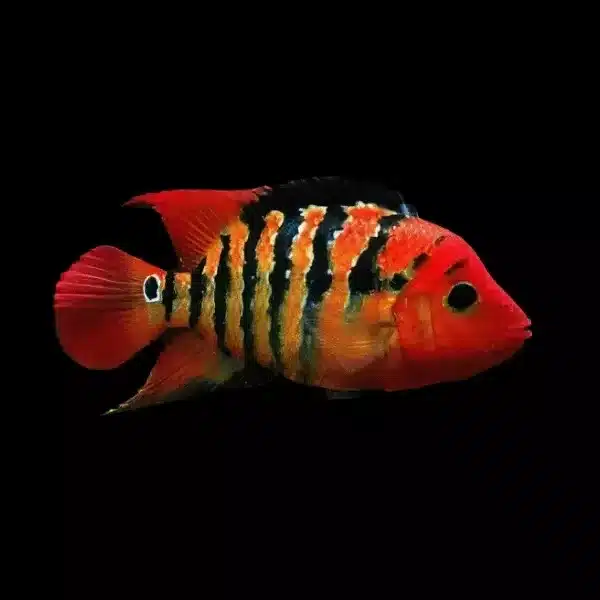
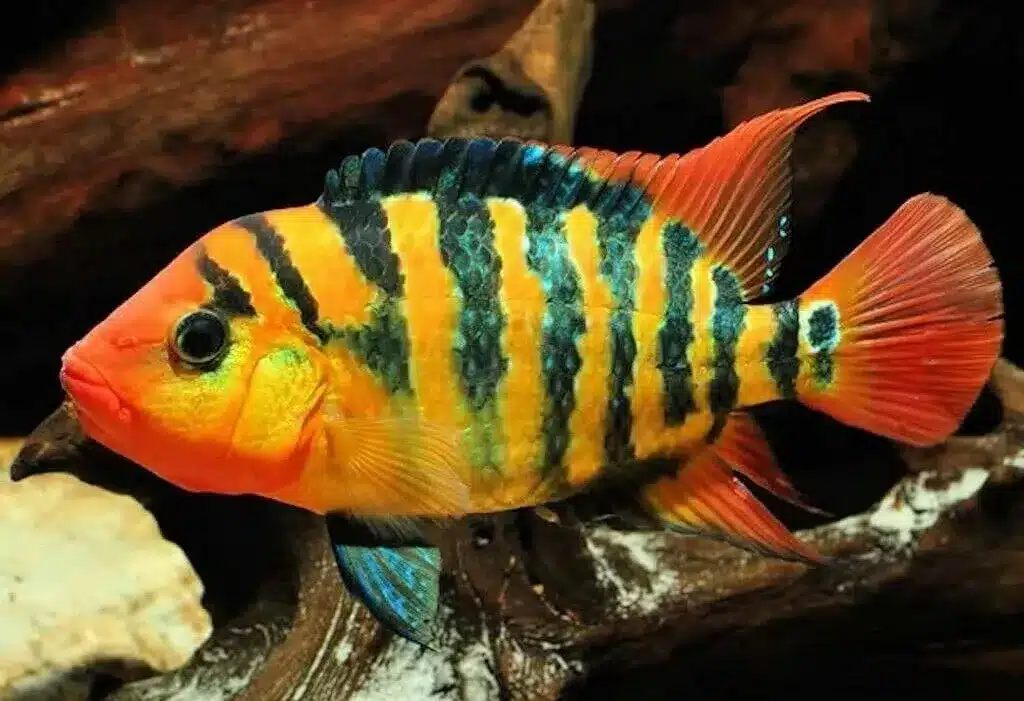
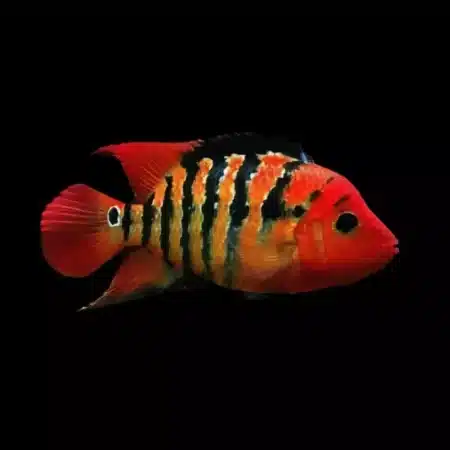
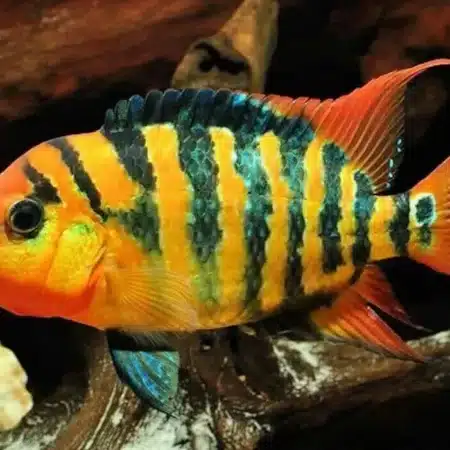
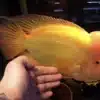
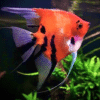









Emily Carter (verified owner) –
I recently added the Andinoacara Rivulatus, also known as the Green Terror, to my 75-gallon tank, and I couldn’t be happier! It’s been about two months, and this freshwater fish has truly brought vibrancy and life to my aquarium. With its striking blue and green coloration, it’s not only a sight to behold but also a robust and active swimmer.
I’ve noticed how it interacts with the other fish; it has a playful yet assertive personality that keeps things interesting. Compared to my previous cichlids, the Green Terror is far more engaging and seems to have a bit more charm. However, I did read beforehand that they can be territorial, so I made sure to provide plenty of hiding spots with rocks and plants, which has really helped keep the peace in the tank.
This fish is perfect for experienced hobbyists like myself who want a dynamic environment. Just a tip: ensure you have suitable tank mates, as they can be a bit feisty! Overall, I highly recommend the Green Terror if you’re looking for a beautiful and lively addition to your aquarium.